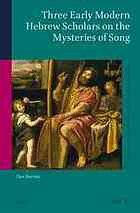Table Of ContentThreeEarlyModernHebrewScholarsontheMysteriesofSong
Studies in Jewish
History and Culture
Editedby
GiuseppeVeltri
EditorialBoard
GadFreudenthal–AlessandroGuetta–HannaLiss
RonitMeroz–ReimundLeicht–JudithOlszowy-Schlanger
DavidRuderman–DianaMatut
volume 47
Thetitlespublishedinthisseriesarelistedatbrill.com/sjhc
Three Early Modern
Hebrew Scholars on the
Mysteries of Song
By
DonHarrán
leiden | boston
Coverillustration:DomenicoZampieri(1581–1641),KingDavidPlayingaHarp(1619).240×170cm
(94.49×66.93inches).Oiloncanvas.Versailles,MuséeNationaldesChâteauxdeVersaillesetdeTrianon
(MV5359).Copyright,Versailles,MuséeNationaldesChâteauxdeVersaillesetdeTrianon.
LibraryofCongressCataloging-in-PublicationData
Harran,Don,author.
ThreeearlymodernHebrewscholarsonthemysteriesofsong/byDonHarrán.
pagescm.–(StudiesinJewishhistoryandculture;volume47)
Includesbibliographicalreferencesandindexes.
ISBN978-90-04-28302-2(hardback:alk.paper)–ISBN978-90-04-28364-0(e-book)1.Moscato,Judahben
Joseph,approximately1530-approximately1593.2.Modena,Leone,1571-1648.3.Portaleone,Abrahamben
David,1542-1612.4.Jews–Music–Historyandcriticism.I.Title.
ML3195.H232014
780.89'924–dc23
2014032288
Thispublicationhasbeentypesetinthemultilingual“Brill”typeface.Withover5,100characterscovering
Latin,ipa,Greek,andCyrillic,thistypefaceisespeciallysuitableforuseinthehumanities.Formore
information,pleaseseewww.brill.com/brill-typeface.
issn1568-5004
isbn978-90-04-28302-2(hardback)
isbn978-90-04-28364-0(e-book)
Copyright2015byKoninklijkeBrillnv,Leiden,TheNetherlands.
KoninklijkeBrillnvincorporatestheimprintsBrill,BrillNijhoffandHoteiPublishing.
Allrightsreserved.Nopartofthispublicationmaybereproduced,translated,storedinaretrievalsystem,
ortransmittedinanyformorbyanymeans,electronic,mechanical,photocopying,recordingorotherwise,
withoutpriorwrittenpermissionfromthepublisher.
AuthorizationtophotocopyitemsforinternalorpersonaluseisgrantedbyKoninklijkeBrillnvprovided
thattheappropriatefeesarepaiddirectlytoTheCopyrightClearanceCenter,222RosewoodDrive,
Suite910,Danvers,ma01923,usa.Feesaresubjecttochange.
Thisbookisprintedonacid-freepaper.
Contents
ListofIllustrations vii
Acknowledgments viii
Introduction:MusicinHebrewWritingsfromtheBibletotheEarly
SeventeenthCentury 1
judahmoscato
Spirituality
1 JudahMoscatoontheSpiritualityofMusic 29
2 SoundsforContemplationonaLyre 47
leonmodena
Legality
3 LeonModenaontheLegalityofArtMusicintheSynagogue 131
4 IsArtMusicPermissibleintheSynagogue? 151
abrahamportaleone
Praxis
5 AbrahamPortaleoneonthePracticeofMusicintheAncient
Temple 177
6 MusicasPracticedintheTempleandtheEarlyModernEra 206
Epilogue:TheJewishContributiontoMusicTheoryintheEarlyModern
Era 254
vi contents
Appendix:TheTextsinHebrew 263
1. Moscato:SermonOne 263
2. Modena:Response 291
3. Portaleone:SelectedChapters 298
Bibliography 314
AbbreviationsandAcronymsinHebrew 340
LexiconofHebrewMusicalTerms 346
IndexofSources 373
GeneralIndex 383
List of Illustrations
1 AthanasiusKircher’sdepictionofthemaḥolasastringinstrumentin
Musurgiauniversalis,1:48–49(1650) 11
2 OpeningofJudahMoscato’ssermon“Higgayonbe-khinnor”(Soundsfor
contemplationonalyre)inSefernefutzotYehudah[BookoftheDispersed
ofJudah],1a(1589) 32
3 OpeningofLeonModena’sresponseonmusicinLondon,BritishLibrary,
msAdd.27148,9a(1605) 139
4 OpeningofLeonModena’sresponseonmusicasprintedinSalamone
Rossi’sHa-shirimasherli-Shelomoh[TheSongsbySolomon],[4]b
(1623) 148
5 OpeningofAbrahamPortaleone’schapter4,inSefershilteiha-gibborim
[BookoftheShieldsofHeroes],onartmusicintheTemple,3a
(1612) 186
6 Women’scourtinancientTemplewithcurvedstaircaseoffifteensteps
leadinguptotheNicanorGate(afterMichaelAviYonah’sreconstruction
oftheTempleinamodelintheHolylandHotel,Jerusalem).Acrossfrom
thecourtwerechamberswhereinstrumentswerekeptfortheuseofthe
Levites(Mishnah,Middot,2:6) 195
7 DavidasharpistinapaintingbyDomenicoZampieri(1619) 197
8 DavidasharpistinaJewishsource:SeferhaggadahshelPesaḥ
[CeremonialoftheHaggadahforPassover],4a(1609) 202
9 Reconstructionofkinnor(harp)asdescribedbyPortaleoneinchapter9
ofSefershilteiha-gibborim[BookoftheShieldsofHeroes],8a–b
(1612) 246
Acknowledgments
IwishtothankBrillforpermissiontouseJudahMoscato’ssermon(chapter2),
originallypublishedinvolume1ofMoscato,SefernefutzotYehudah[Bookof
the Dispersed of Judah], Hebrewtext (Venice1589), in an annotated English
translationin JudahMoscato,Sermons:VolumeOne,editedbyGiuseppeVeltri
andGianfrancoMilettoinconjunctionwithGiacomoCorazzol,ReginaGrund-
mann,DonHarrán(Sermon1),YonatanMeroz,BrianOgren,andAdamShear
(Leiden,Boston,ma:Brill,2011),63–123(English),הכ–אי[11–25](Hebrew).Ialso
wishtothanktheAmericanInstituteofMusicologyforpermissiontouseLeon
Modena’s response (chapter 4), originally published in my edition of Salam-
oneRossi’sHa-shirimasherli-Shelomoh[TheSongsbySolomon]involume13a
of Rossi’s CompleteWorks (Middleton, wi: American Institute of Musicology,
2003),193–211.Inbothcases,thematerialhasbeenrethoughtandcompletely
revised.
An important work, though one that treats Hebrew music theory in an
entirely different way, is the recent book to be mentioned by Dov Schwartz,
Kinornishmati.TouchingonthethreeauthorsMoscato,Modena,andPortale-
oneonlymarginally,itattemptsrathertolocatewiderstreamsofthoughtin
Jewish practice.One significant explanation of a major passagein Moscato’s
sermonwillbehighlightedinchapter1.
I could not have written this book without my wife, who understood and
encouraged.NorcouldIhavewrittenitwithouttheresearchofmycolleagues
innumerousareasofinquiry.Jewishstudiesappeartobethrivingtoday.Were
thisstudyof“ThreeEarlyModernHebrewScholarsontheMysteriesofSong”to
addinsomewaynotonlytothe“mysteries”ofsongbutalsotoJewishmusical
thoughtinitsintricateramificationsforallfieldsoflearning,itsgoalwillhave
beenachieved.
introduction
Music in Hebrew Writings from the Bible
to the Early Seventeenth Century
At the center of this study are three major writings on Hebrew music the-
ory from the early modern era: a sermon by Judah Moscato, a question to
whichLeonModenarepliedinaresponse,andselectedportionsfromatrea-
tise by Abraham Portaleone. In length and significance they form the high
pointinaspecificallyHebrewtraditionofmusicalthought.Thetraditiondevel-
opedalongsideancientGreekandmedievalIslamicandEuropeanwritingson
music,andoftendrewfromtheirsubjectsinacomplexpatternofculturaland
conceptual interchanges. Yet it differs from them in having its own intrinsi-
callyHebrewsourcestraceableintheirthemesandcontentstotheBible,the
Mishnah,theTalmud,andlaterrabbinicalwritings,someofthemlegalintheir
approach,othershomiletic,philosophical,andkabbalistic.Thepurposeofthis
introductionistodescribethesourcesasthehistoricalbackdropforthethree
writings.
AnytreatmentofearlyHebrewmusictheoryinevitablyrestsontheachieve-
mentsofnotedscholars,amongthemEricWerner,HanochAvenary,Amnon
Shiloah,andIsraelAdler,thelastofwhom,inanannotatedHebrewtranscrip-
tion,presentedawidecorpusofHebrewwritingsonmusicfromtheearlytenth
toearlyseventeenthcenturies.1Theliteraturebytheseandotherauthorities
includesstudiesthatsummarizethebibliographyofJudeo-Arabicwritingson
music2andthatdealwithindividualworks,3someofthemadditionstothose
1 HebrewWritingsConcerningMusicinManuscriptsandPrintedBooksfromGeonicTimesupto
1800,ed.IsraelAdler.Fortheothers’works,seethefootnotesbelowandtheBibliographyat
theendofthisvolume.
2 Forthosedealingwithbibliography,seeEricWernerandIsraelSonne,“ThePhilosophyand
TheoryofMusicinJudeo-ArabicLiterature”;HanochLoewenstein(laterAvenary),“Ḥokhmat
ha-musikahbi-mekorotyehudiyyimme-ha-meʾahha-yodve-ʿadha-meʾahha-yodzayin”[The
ScienceofMusicinJewishSourcesfromtheTenthuntiltheSeventeenthCenturies];Hanoch
Avenary,“Ḥokhmatha-musikahbi-mekorotyehudiyyimbi-yemeiha-beinayimu-vi-tekufat
ha-teḥiyyah”[TheScienceofMusicinJewishSourcesintheMiddleAgesandthePeriodof
theRenaissance](arevisedversionofthepreviousitem).
3 E.g.,IsraelAdler,“Fragmenthébraïqued’untraitéattribuéàMarchettodePadoue”;Ave-
nary, “The Hebrew Version of Abū l-Salt’s Treatise on Music”; Miriam Ben-David Sheer,
© koninklijkebrillnv,leiden,2015 | doi:10.1163/9789004283640_002
2 introduction
inAdler’svolume.4Allinall,thenumberofprimarysourcesislimited—maybe
sixtytoseventy.Nolesslimitedistheircoverage:sometimesmusicisaddressed
inasingleparagraph,othertimesinasinglechapterorinscatteredreferences
inoneormorechapters.Onlyrarelydoesonefinditasconsistentlyandcal-
culatedlytreatedasinthethreewritingsbyMoscato,Modena,andPortaleone,
hencetheirprominenceintheliterature.
For Avenary, Hebrew writings on music divide into three periods: those
frombeforethefourteenthcentury,ofIslamicorigin,and“assimilatedbythe
Jewishpublicintheiroriginalform,thoughwritteninHebrewletters,”orthe
sameinHebrewtranslations,orindependenttractatesbyJewsinbothHebrew
and Arabic; the “Ars Nova” and its continuation into the early Renaissance
(fourteenth and fifteenth centuries); and the Renaissance proper (sixteenth
andseventeenthcenturies).5
Morefundamentally,theperiodizationforcesthequestion:howdoesone
define a Hebrew writing on music? The coverage is broader than one might
expect. Not only does it include all works on music written in Hebrew, but
itdoesothersoriginallywritteninArabic,yettranscribed,asnotedabove,in
Hebrewletters;forexample,thefew,thoughsignificantreferencestomusicin
Seferha-Kuzari[BookoftheKhazar]byJudahHalevi(d.1141).6Totheseone
might add works on music by Jews, Moslems, or Christians in Arabic, Latin,
orItalian,yettranslatedintoHebrew—forexample,theHebrewtranslation,
by Judah ben Saul ibn Tibbon (d. after 1190), of the same writing, in Arabic,
byJudahHalevi;orananonymousLatintreatiseonmusicaplana(plainchant)
translatedintoHebrewbyJudahbenIsaac(fourteenthorfifteenthcentury);
or a treatise on musicaplana thought to have been written by Marchetto da
Padua(fl.1305–1319)andtranslatedbyanunknownscribefromLatinorItalian
intoHebrew—allthatremainsofitisitsinitialpart.7Theunifyingelementin
“Delmedigo’sSeferElimasaHebrewSourceonMusicTheory”;H.G.Farmer,Maimonideson
ListeningtoMusic;idem,SaadyahGaonontheInfluenceofMusic;AmnonShiloah,“‘EnKol’—
CommentairehébraïquedeShemTovibnShaprutsurleCanond’Avicenne”;idem,“The
MusicalPassageinIbnEzra’sBookoftheGarden”;andJosephSmitsvanWaesberghe,“The
TreatiseonMusicTranslatedintoHebrewbyJudabenIsaac(ParisB.N.Héb.1037,22v–27v).”
4 E.g.,Shiloah,“APassagebyImmanuelha-RomiontheScienceofMusic”;andAdler,“Liku-
timbe-ḥokhmatha-musikahbi-khetavyadLondon,ha-sifriyyahha-beritit,Or.10878”[Col-
lectaneaConcerningMusicintheHebrewManuscriptLondon,BritishLibrary,Or.10878].
5 Avenary,“Ḥokhmatha-musikah,”158.
6 JudahHalevi,Seferha-Kuzari(1506),[21]b–[23]a.
7 See,forthethree,HebrewWritingsConcerningMusic,ed.Adler,respectively198–201,81–88,
and207–208.

